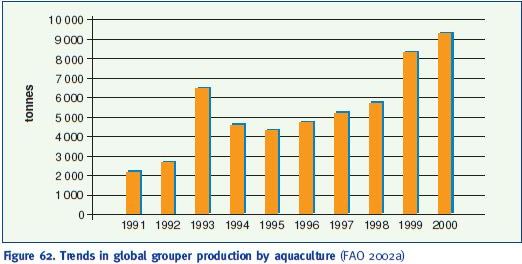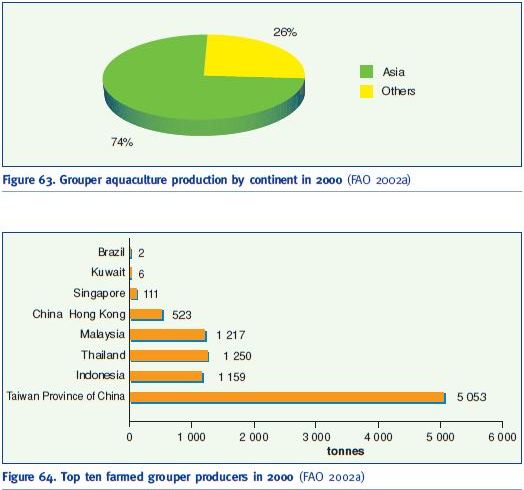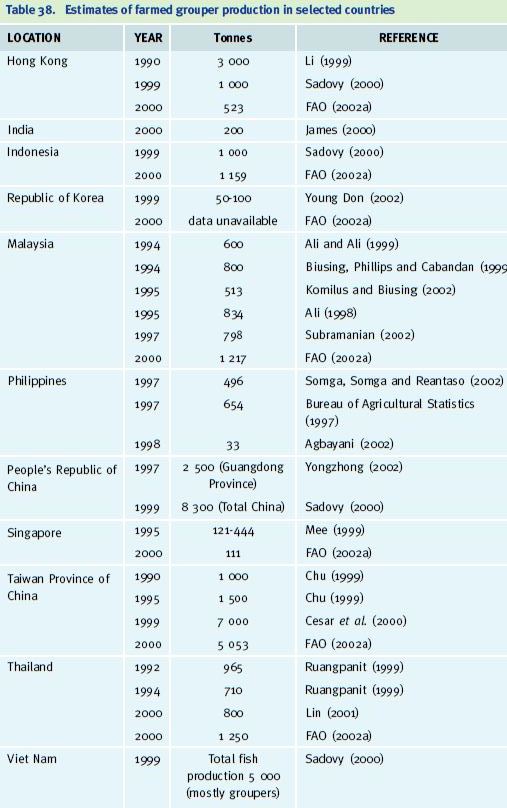Trends in aquaculture production - grouper
Groupers are cultured in many Southeast Asian countries, including Indonesia, Malaysia, Philippines, Taiwan Province of China, Thailand, Hong Kong, the southeast of the People’s Republic of China, and Viet Nam – as well as other parts of the tropics in the south eastern USA and Caribbean. Grouper culture is also undertaken in India, Sri Lanka, Saudi Arabia, Republic of Korea and Australia.
Eating live seafood (i.e. seafood that is kept alive until immediately before cooking) is a strong tradition among consumers along the southeast coast of China. In recent years this culture has spread to neighbouring countries with large Chinese populations, including Taiwan Province of China, Singapore, Hong Kong, Malaysia and Thailand. The Chinese word for “fish” has the same pronunciation as the word for “plentiful” and is an important symbol in traditional Chinese agricultural society. Fish are important components of all dinner receptions. In Hong Kong 95% of all restaurants are Chinese, and most serve live seafood (Chan 2000b).
Despite their popularity, only 15-20% of the amount consumed each year comes from aquaculture, as culture is principally constrained by limited and unreliable supplies of wild “seed” and the difficulties of spawning in captivity. However, hatchery production has increased in recent years (for example in Taiwan Province of China and Kuwait) (Tucker 1999). It is difficult to get accurate statistics on farmed grouper production because those simply being caught from natural sources and held for a few weeks in cages before being sold, and those cultured for a longer period of time are not differentiated. Data shown in this report have come from FAO and other sources.
Figure 62 shows recent trends in grouper aquaculture production. These statistics consist of official national returns to FAO based on commercial, artisanal and subsistence aquaculture, and are considered to be underestimates.

Figure 62. Trends in global grouper production by aquaculture (FAO 2002a)
According to Figure 63, grouper production through aquaculture is mainly reported by countries in Asia, where over 9 300 tonnes were produced in 2000. The actual figures of grouper production in SE Asia are reported by Sadovy (2000) to be far higher, at 23 000 tonnes; however, about 20% of this production may be based on hatchery produced fry, while the remainder is from wild seed. According to this author, China is the main producer (8 300 tonnes). Kongkeo and Phillips (2002) estimated Asian production to be around 15 000 tonnes. In each case, these figures are significantly higher than the official statistics published by FAO.
Figure 64 shows data on the top ten grouper producing countries in 2000. According to official statistics, Taiwan Province of China was the leading producer, with nearly 5 100 tonnes (54% of the global total).

Figure 63. Grouper aquaculture production by continent in 2000 (FAO 2002a)
Figure 64. Top ten farmed grouper producers in 2000 (FAO 2002a)
A total of 7 200 tonnes was produced in brackish water in Taiwan Province of China, Malaysia and Thailand. The remaining production was from mariculture: a total of 2 100 tonnes, mainly in Indonesia, Hong Kong and Taiwan Province of China.
Table 38 presents data for grouper culture production made by various authors, compared with FAO data. The absence of homogeneity is obvious. Accurate information is difficult to obtain; hence the production estimates vary significantly, depending on the authors’ sources. Their data comes from interviews, questionnaires, literature reviews and pers. comm. gathered by each author. When information is collated from a variety of sources, e.g. government offices, private producers, traders, middlemen, exporters and importers, and from fishing communities, academic institutions and hatcheries, etc., it is not easy to obtain reliable estimates.
Table 38. Estimates of farmed grouper production in selected countries
